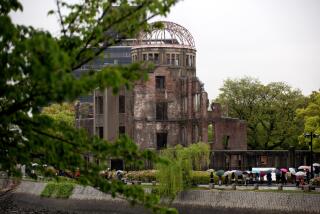Nazi Germany Was Planned Target : Creation of Anthrax Bomb Told
STANFORD — Britain and the United States developed and began to manufacture deadly anthrax bombs for use against Germany in World War II, but never decided to use them, according to a new report by a Stanford University historian.
Prof. Barton J. Bernstein declared in an interview and in an article in the Bulletin of Atomic Scientists published Monday that an American plant, “probably in Vigo County” near Terre Haute, Ind., was scheduled to make about 50,000 bombs monthly by the summer of 1944, and 250,000 by that year’s end.
In documents examined by Bernstein, British Prime Minister Winston Churchill was advised that 1,000 projectiles, each of 500 pounds and containing 106 four-pound anthrax bombs, could destroy life in a 25-square-mile area. Potential targets included Berlin, Hamburg, Frankfurt, Aaachen and Wilhelmshafen.
American production of the bombs fell too far behind schedule to make available enough of the anthrax weapons in 1944, Bernstein said, and by 1945 “Germany was near surrender.”
Geneva Convention
Use of the bombs would have violated the Geneva Convention, signed in 1925 by the United States and Britain. But in mid-1944, outraged and furious by the German V-1 bombings of Britain, “Churchill might well have seriously considered retaliating with anthrax bombing,” Bernstein noted.
The British also devised a plan in 1945 to drop the bombs on six German cities “but I can’t tell if that was a contingency plan or something that would be used,” Bernstein said. “Churchill’s advisers knew when they devised the plan that the bombs wouldn’t be ready.”
“My guess is he (Churchill) wouldn’t have used them because F.D.R. (President Franklin D. Roosevelt) would have vetoed it,” Bernstein said. “F.D.R. was troubled by gas warfare and probably would not have allowed the anthrax bombs to be used because of moral reasons. It’s less certain about how Churchill felt, although we know he favored the use of gas.”
U.S. Construction
Bernstein said the British contracted for anthrax bomb plants in the United States because such plants in Britain would be vulnerable to bombing and therefore a greater threat to the local population.
“It is impossible to know how many bombs were made (after the initial order was filled) because the American records were either destroyed, lost or classified,” Barton said. “But it’s likely that other bombs were made, and I would love to know what the U.S. did with them.”
Bernstein is a member of Stanford’s Center for International Security and Arms Control. His article is part of a larger research project entitled “Deterrent, Morality and Awful Weapons in World War II.”
Historical Documents
According to documents that the historian said he examined in England, Lord Cherwell, Britain’s chief scientific adviser, informed Churchill in February, 1944, that “any animal breathing in minute quantities of these N (anthrax) spores is extremely likely to die suddenly but peacefully within the week.”
The head of the British Medical Council’s Bacteriological Metabolic Unit unleashed anthrax experimentally on the small island of Gruinart, off the Scottish coast, soon after the war began. The island remains uninhabitable today.
More to Read
Sign up for Essential California
The most important California stories and recommendations in your inbox every morning.
You may occasionally receive promotional content from the Los Angeles Times.










